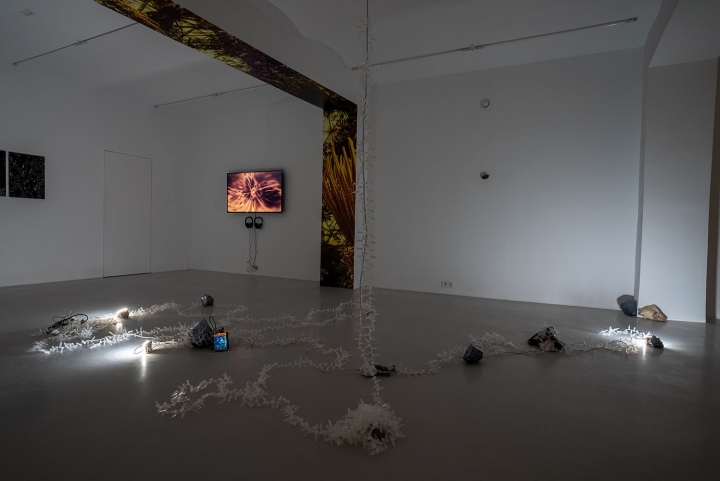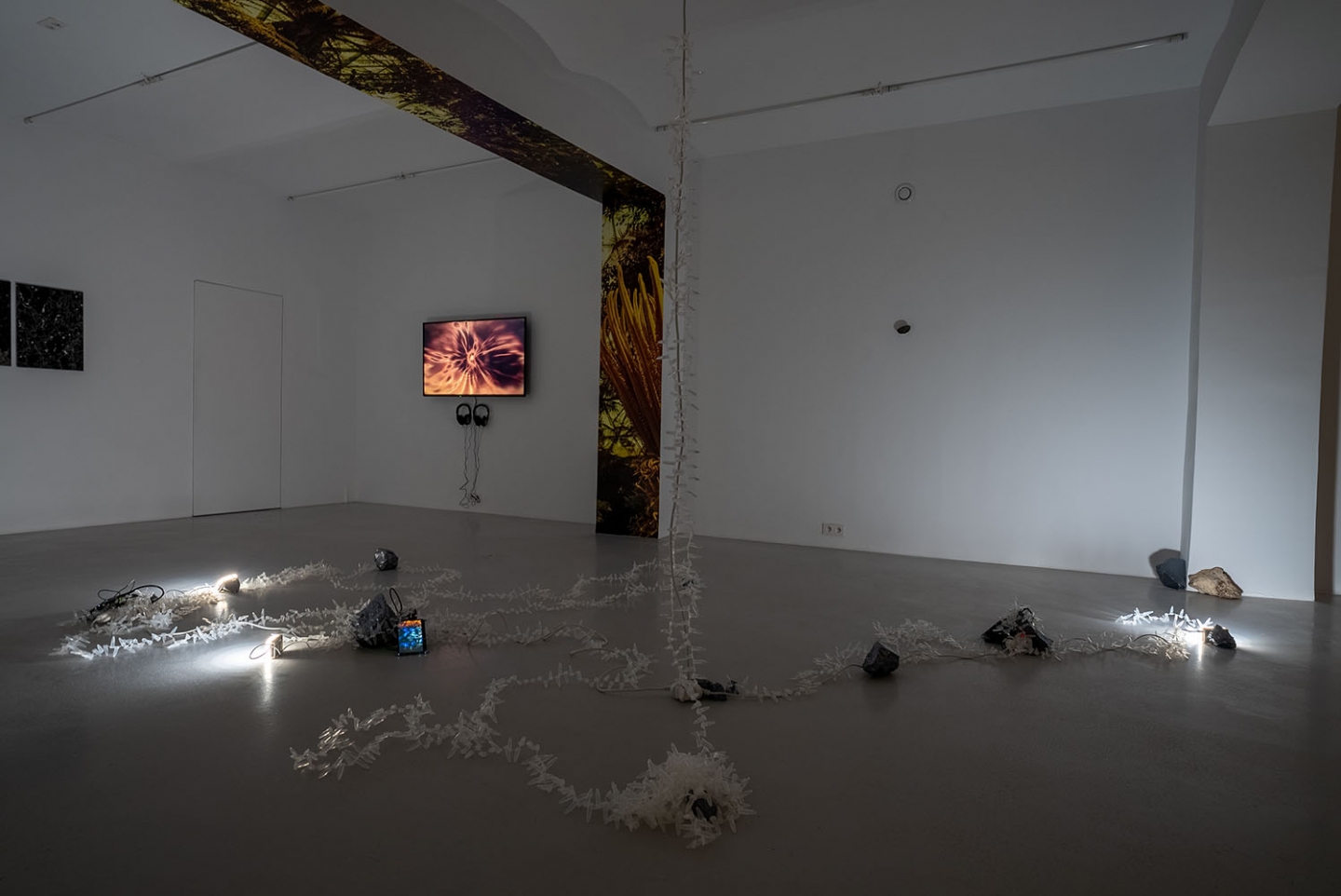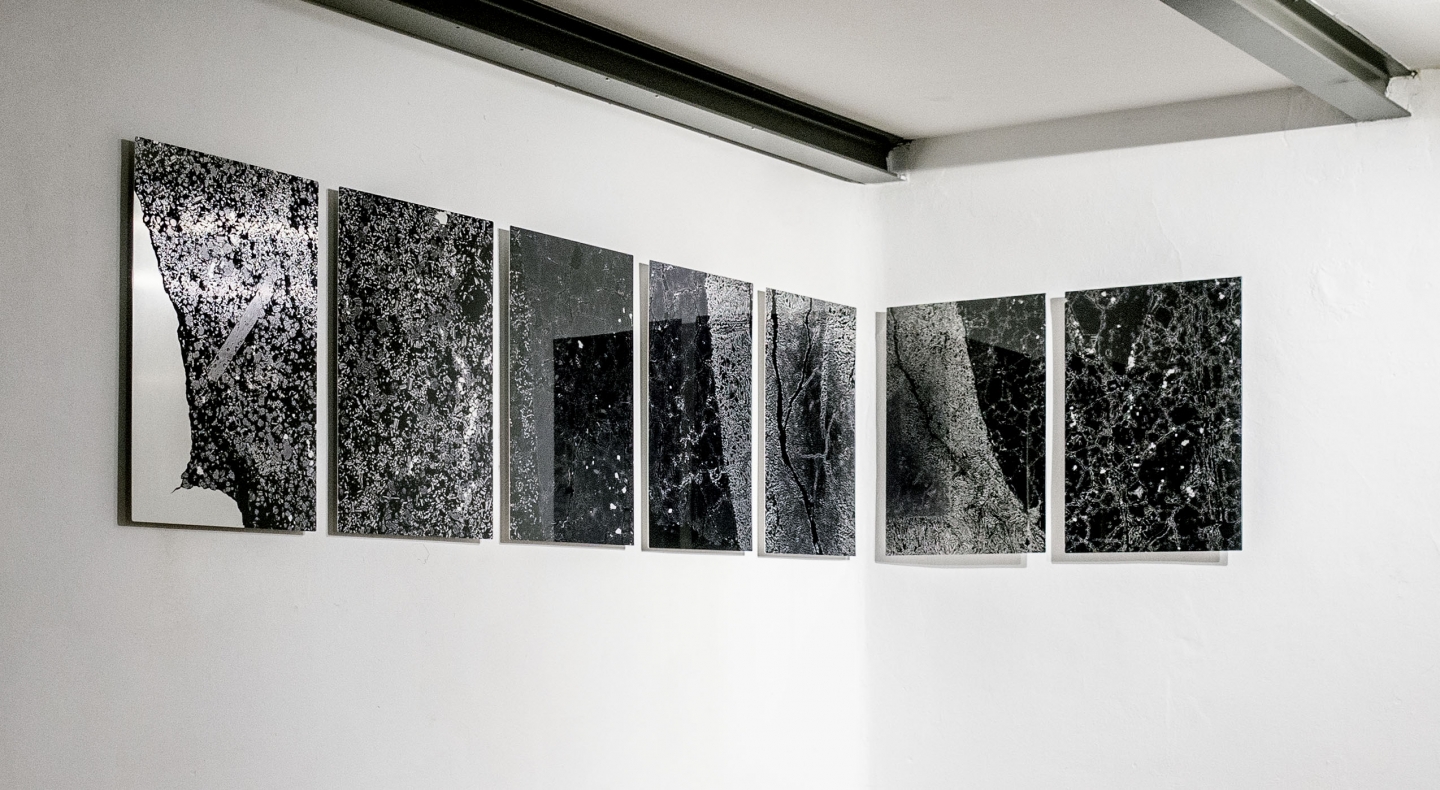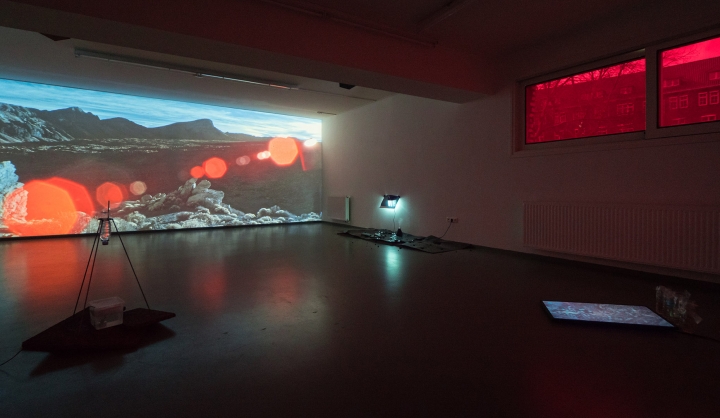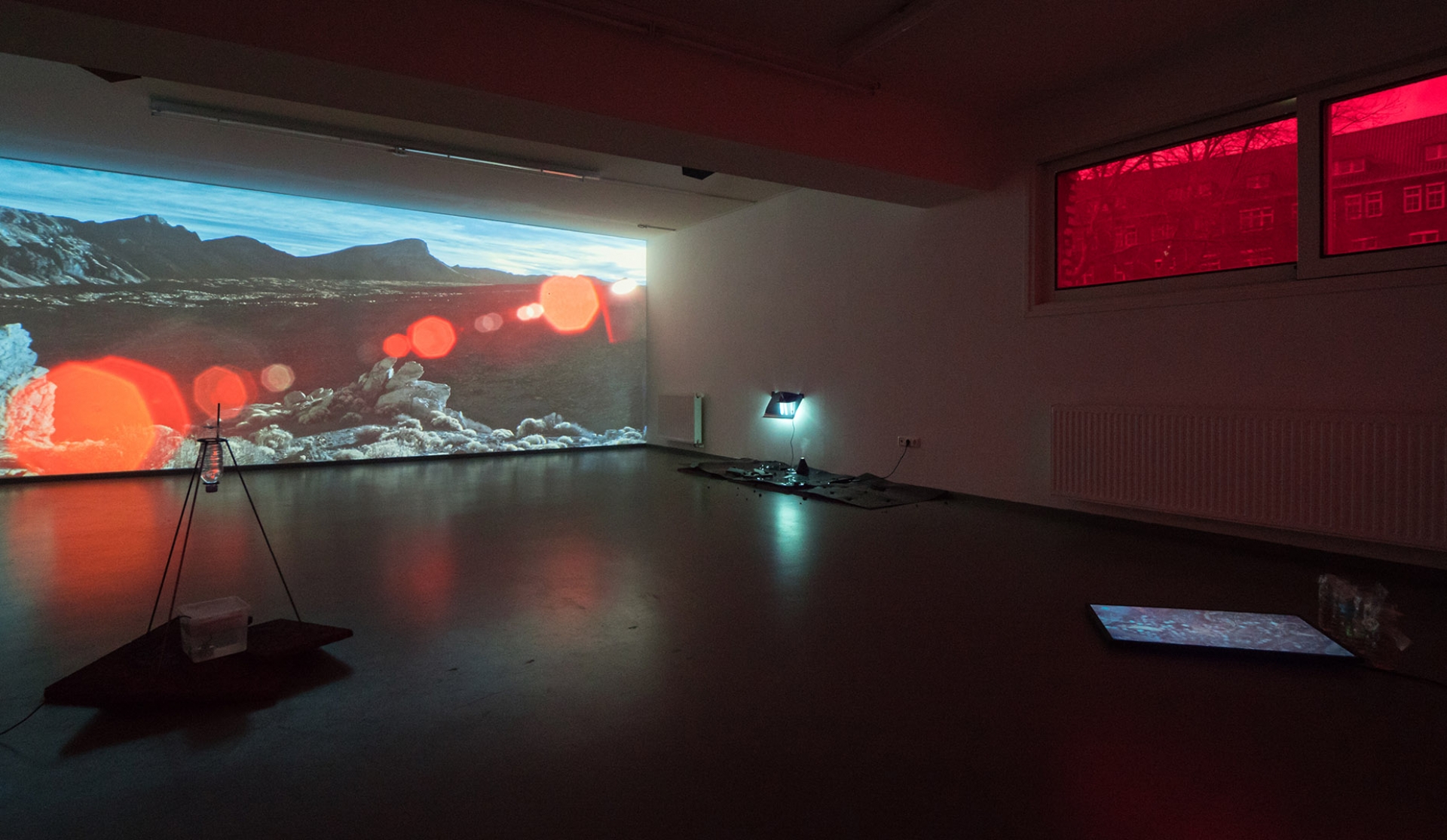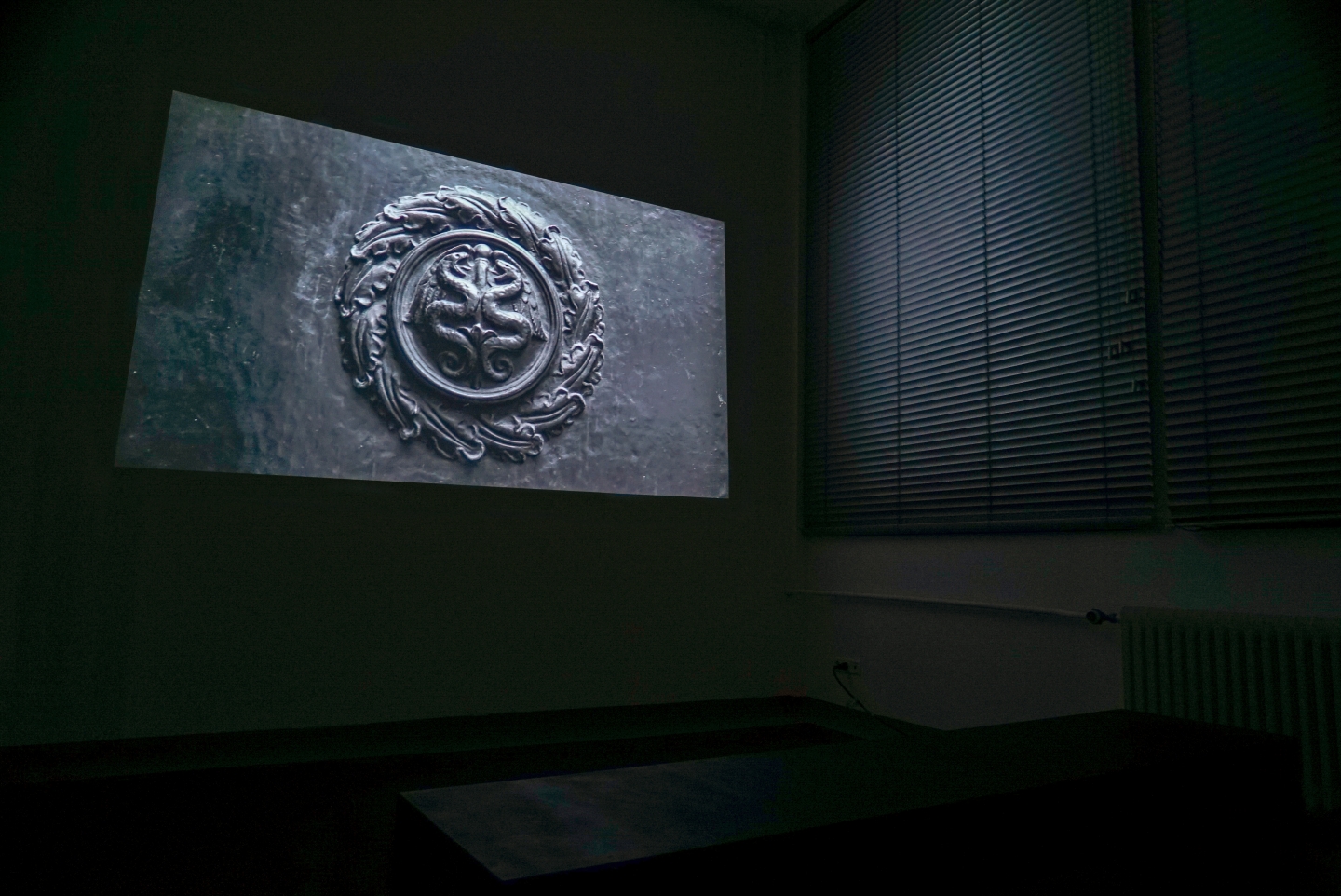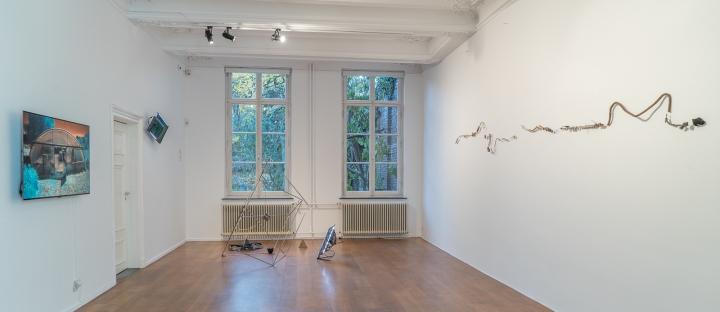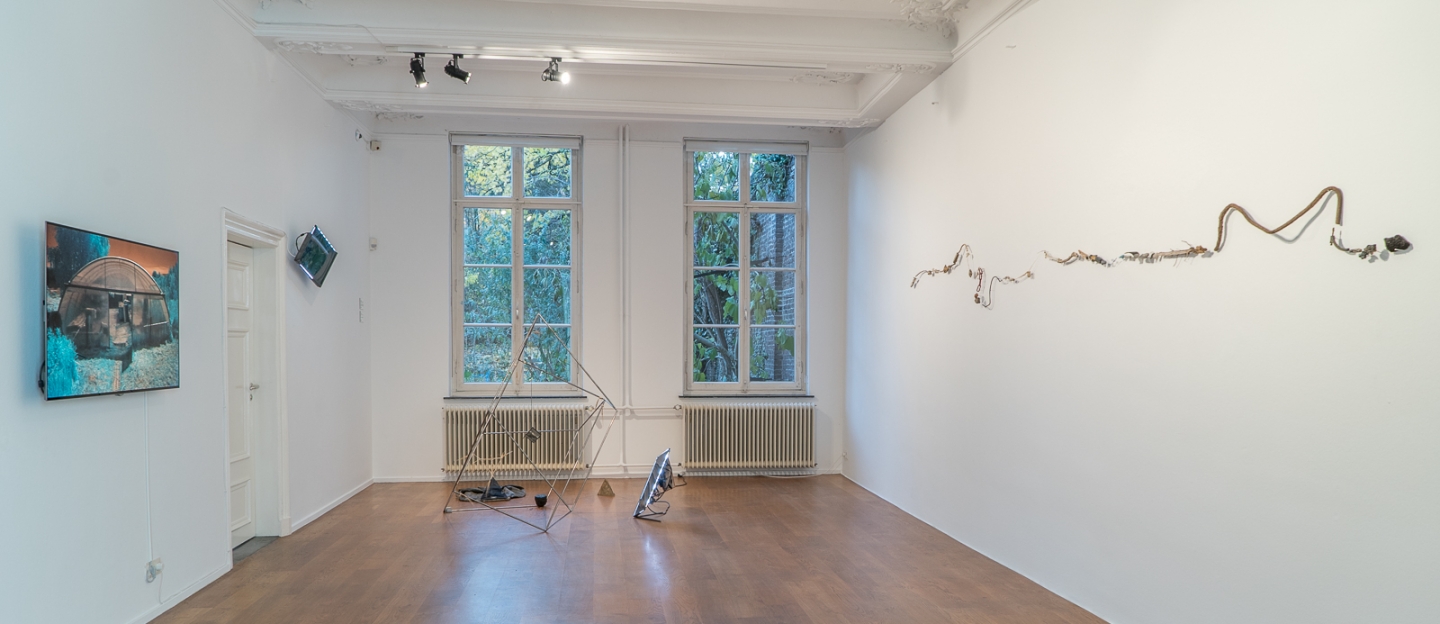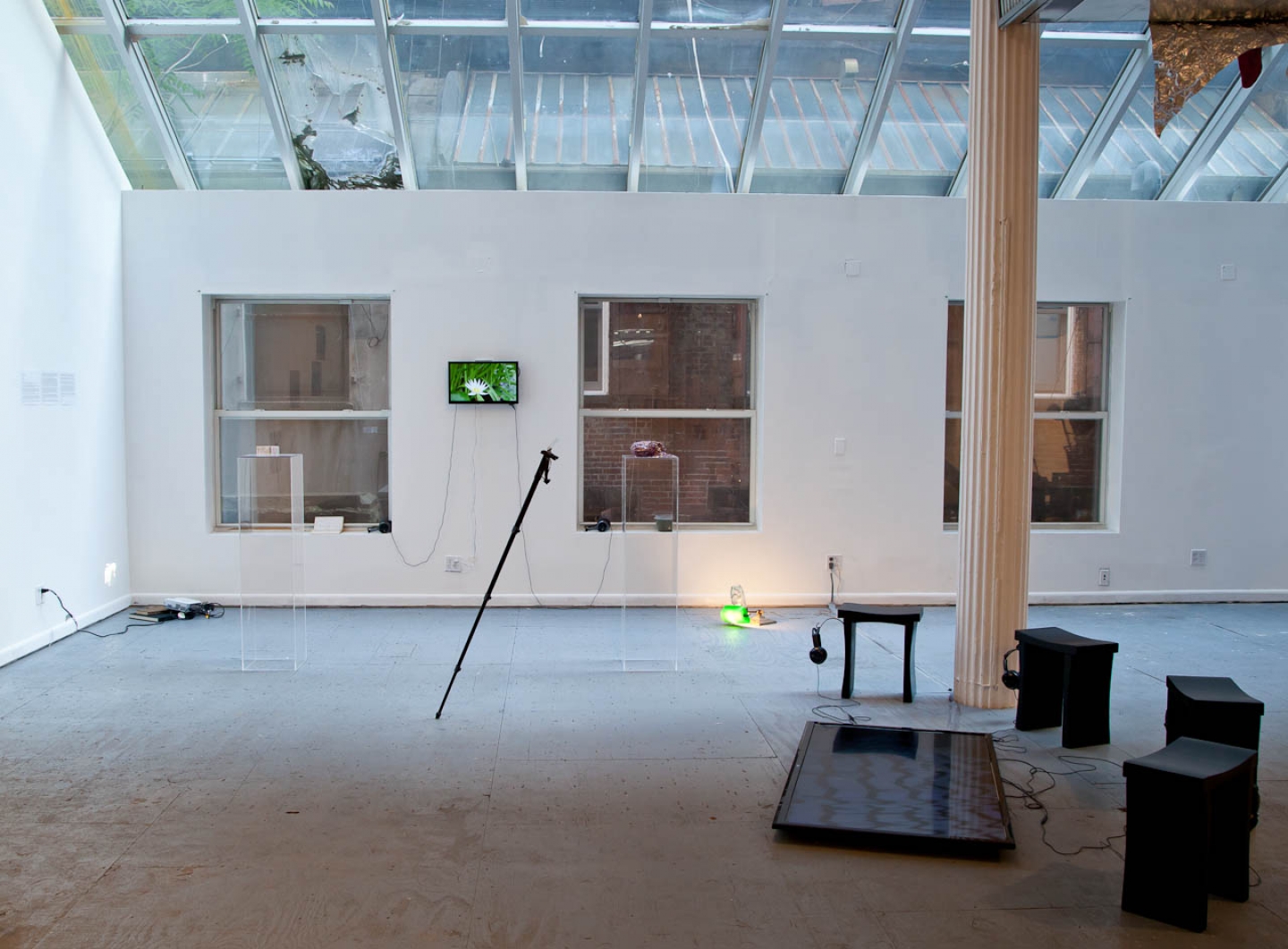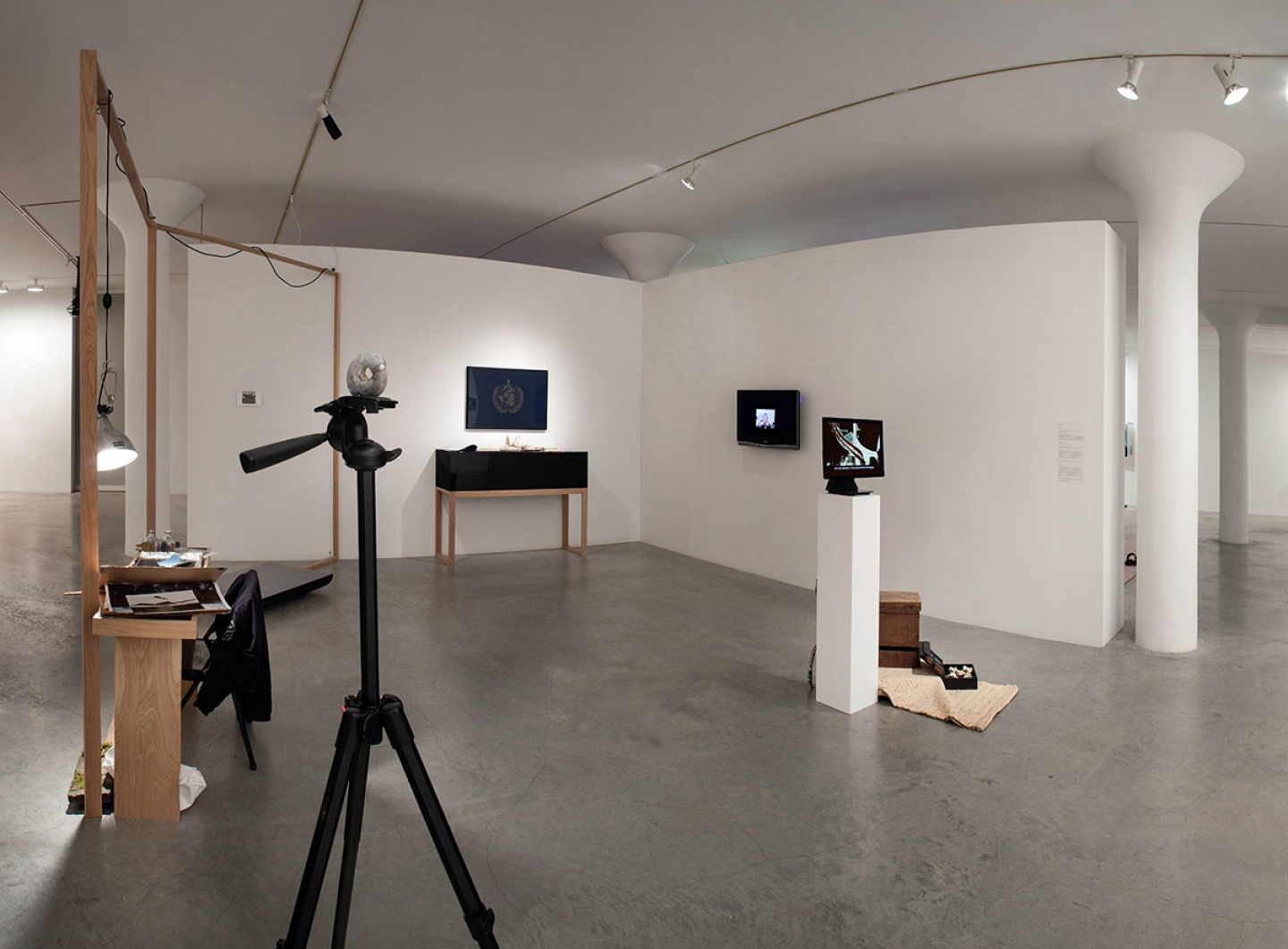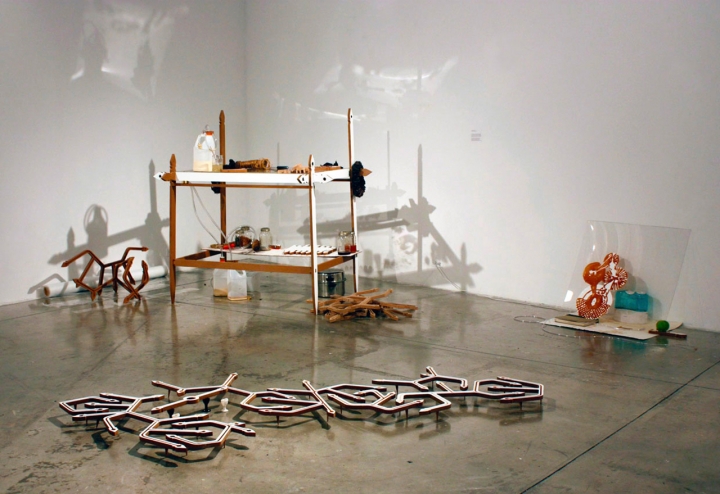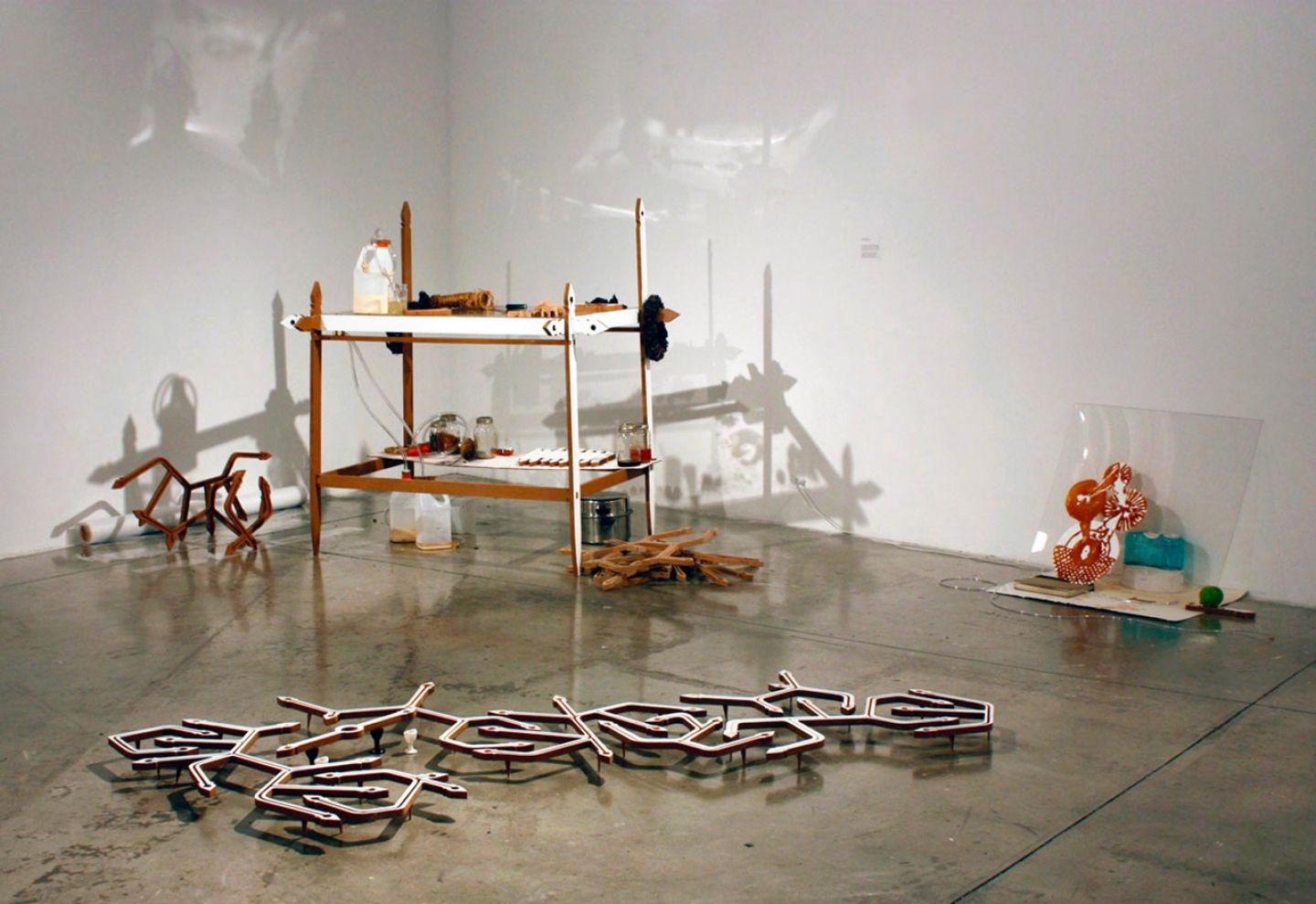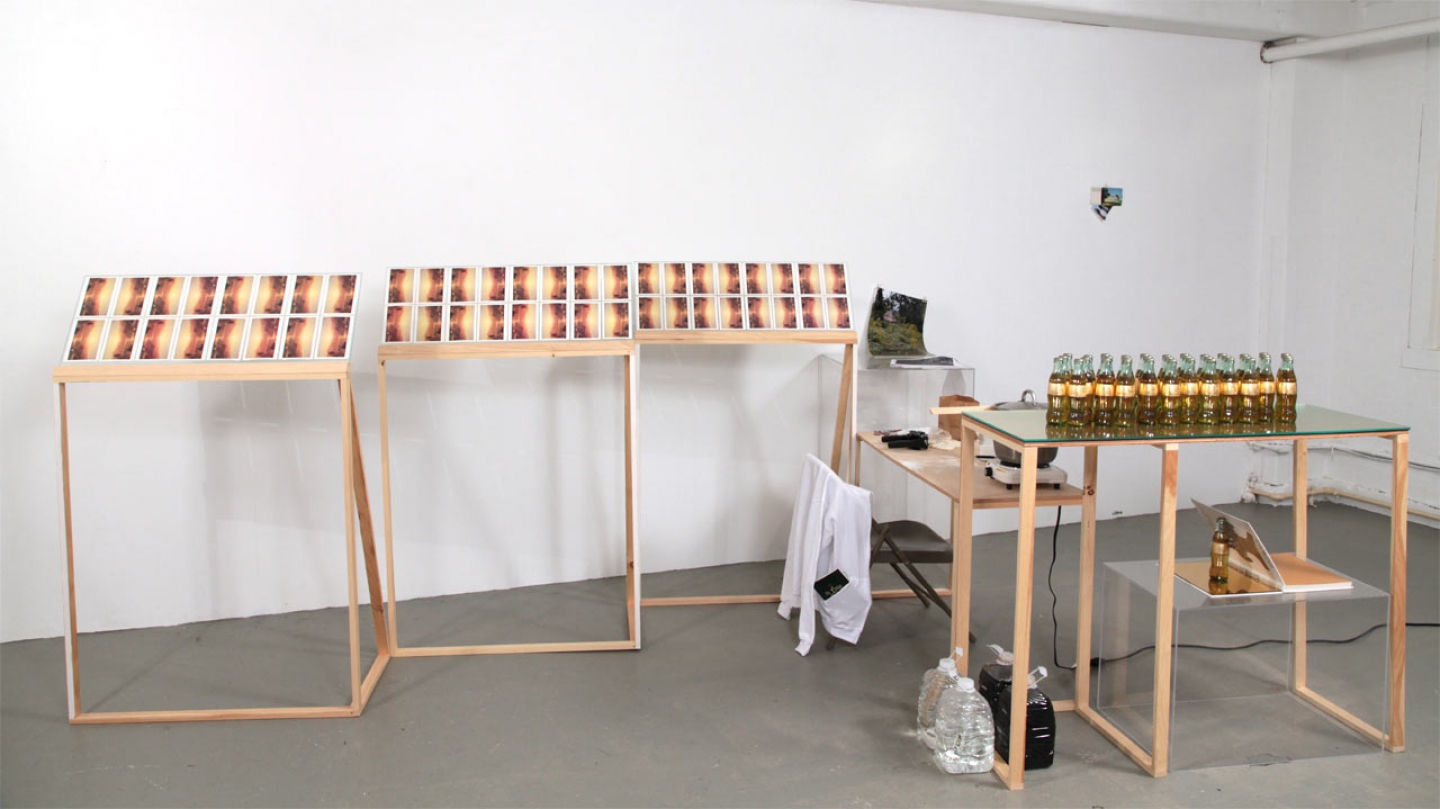Selected Projects/Installations
Factitious Reservoirs
Simulated brines in centrifuge vials, pure silicon, videos, LED lights, electrical cords
Brine recipes of the moon Europa, the moon Enceladus, and the dwarf planet Ceres courtesy of Mark Fox-Powell (astrobiologist and planetary scientist at Open University, UK); in addition to the base recipes more speculative recipes were also developed. Video source material generated from a custom model/image data set—around the theme of alien oceans using—StyleGAN2. Developed as a site specific installation in dialogue with exhibition curator, Arkadiusz Półtorak.
Produced with the support of the Mondriaan Fonds.
Factitious Earths
Infused aluminum prints of scanning electron microscope images, glass vial with “factitious earths” custom mixture, glass vial with platinum capsule of “factitious earths” experiment.
Working with experimental geologist Geoffrey Bromiley, a new planet’s geology was modeled on: archival research into the use of carbonic acid as a restorative gas by steam engine inventor James Watt to heal his invalid geologist son; deep earth carbon processes; runaway hot-house earth scenarios, and the speculative geology of a hypothetical exoplanet.
A Projection of the Colonial Imaginary
This body of work approaches the Canary Islands as a site which attracts agents that explore, claim, colonize and transform worlds. Christopher Columbus departed from the Canary Islands on his journeys to claim whatever he “found,” helping inaugurate Modernity — a transformation structured on lasting social inequalities, set in motion with great loss of life and freedom to colonized people. The night sky by which early explorers navigated is now mapped by the gaze of optical/infrared telescopes that dot the peaks of the islands — islands once at edge of ancient Greek maps. While colonial ships required captain and crew, autonomous planetary rovers are currently being tested on Canarian volcanic terrain standing in for alien landscapes. Lichen are colonizers of barren rocks like volcanic landforms; the organism’s ability to withstand radiation makes them prime candidates to terraform other planets. When intelligent robots and lichen become the first colonizers of other planets, then what?
Within the Temple Without
Official selection of IFFR - International Film Festival Rotterdam
“Within the Temple Without” is a journey into the economic unconscious—which is now collective and digital. This journey takes the structure of a dream. The pathway to the Temple of Apollo in Delphi is lined with treasuries for the gods; the alchemical symbol of the caduceus, carried by Hermes, was created from the expulsion of serpents at the Temple of Apollo. The caduceus and other alchemical symbols can be found all over the Bank of England, which drew on alchemical ideas to develop a credit based currency; it became the template of central banks. The Bank for International Settlements in Basel Switzerland is the central bank of the central banks and largely exists outside of any governmental jurisdiction. Handheld video has been algorithmically stabilized, creating an unstable frame and uncanny, convulsing images. Carl Jung’s work with alchemy and the unconscious—both individual and collective—further informs the work. The narrative itself is delivered by a computer application rather than a human. Manipulated and composed sounds from ATMs provide the soundtrack.
Metabolization Sequence / Disarticulation Sequence / Propagation Sequence
These three “sequences” were developed from working in archaeological contexts—in collections, laboratories, and excavation sites. The works pursues an archeology that eschews the centrality of humans and instead engages with the entanglements of an anthropos—from metabolic to ecological—ensnared in deep time’s surreal dimensions. The work is oriented around 3 archeology sites: a pre-Homo sapiens lower Paleolithic site more than 335,000 years old; a 40-50,000 year old middle Paleolithic site with Neanderthal and Homo sapiens layers; and a Neolithic site from approximately 5,500 years ago. Taken together the installation uses the ancient past to offer views on how the momentum of the present propels us towards the future.
Funding provided by the European Commission/NEARCH
Heirs of the Royal Art
Heirs of the Royal Art casts a constellation including intoxicating water lilies used in elite funeral rites in ancient Egypt, Claude Monet’s Giverny water lily gardens; a wealth Management company called Giverny Capital; the collusion of art and economy through JPMorgan Chase’s wealth management arm “ Chase Private Client”; the Chase Bank corporate collection started by then Chase President David Rockefeller at the same time as his involvement in the Museum of Modern Art; Rockefeller’s personal acquisition of some of Monet’s near abstract water lily canvases; and the role of JP Morgan and other financiers in the founding of the Egyptian collection at the Metropolitan museum in 1906 which features items from their private collections depicting the sacred and intoxicating blue water lilies.
Medicine Men
Medicine Men examines cyclical patterns, a web of relations, and genealogies in relation to medicine, economy, and power (following the Rockefeller Family) on the one hand and to cosmic and psychic forces (following myths of snakes/serpents) on the other hand. I present photographs, video, objects, books, and various historic material in a sculptural installation which shifts between workshop, lab, office, and museum.
Poisons
“All things contain poison,” our beloved Paracelsus wrote, “there is nothing without poison.”
The same plant to cure and to kill. Tobacco is radically altered in different cultural contexts. It is used in ritual healing ceremonies in South America and has come to be known primarily as an addictive carcinogen throughout the rest of the world – a side effect of Colonialism.
Poisons constitutes a sculptural system in which the objects have been activated through use. However, visitors are confronted not with a performance, but only the residue of action and the events already past.
The work engages with how both the material thing is produced and how meaning is produced; so the installation included the equipment needed to produce the sculpture. Installing the “vessels” required filling all them. This was done using Victorian eye wash cups from which two substances were imbibed: Cat's Claw/Una de Gato liquid (a plant from the rainforest known to fight cancer) and the liquid Tobacco juice.
The Golden Hour
From Saint John Chrysostom (“Golden Mouthed”) Melkite Church (former home of Coca-Cola magnate Asa Candler) to Frederic Church via coca and shamanic gold work: Coca tea brewed as medicine with water from Hudson River School landscape painter Frederic Church’s home, Olana, was bottled in gold-leafed Coca-Cola bottles. This action exists in relation to Reichel-Dolmatoff’s Goldwork and Shamanism An Iconographic Study of the Gold Museum of the Banco de la Republica, Colombia and postcards of Church’s painting The Andes of Ecuador which is housed in tobacco baron R. J. Reynold’s former home, now an art museum.
